|
Zulu Nyala, South Africa
Sunday Morning, September 10
When we met up with Marius for the morning drive, he had some good news to share: he got us into an afternoon/evening tour at the neighboring reserve. Part of CC Africa, Phinda is very expensive and exclusive, and they only occasionally allow tours for guests not staying at their lodge. We'd been hoping for this all week; very exciting news.
Excitement about the afternoon drive didn't detract from our morning drive. There's always something new to see even driving through familiar territory.
We saw George the giraffe drinking from a water pool, quite an undertaking for a giraffe. The photo below shows how he has to spread his forelegs out so that he can reach all the way down to the water.
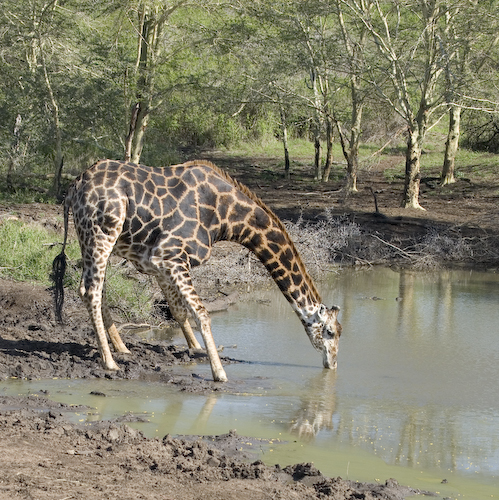
We paused to examine some of the nasty "hook and pinch" plants that the giraffes like to eat and got photos of their multiple thorn and hook structures. These same trees are a constant hazard to us as we're driving through narrow dirt roads, but at least we don't have to figure out how to eat them without tools or even hands.
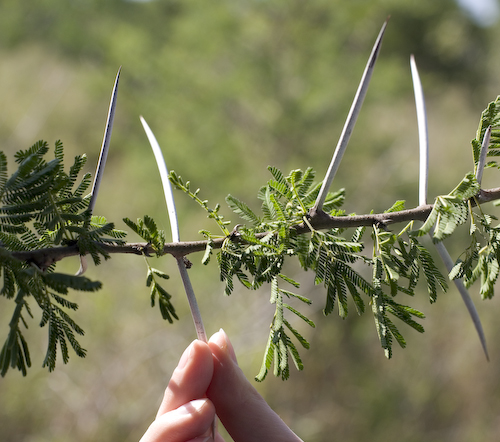
Between the big obvious spikes are much smaller hook thorns. Look at the top of the stem about an inch to the right of the thorn Cathy is holding. There is also one to the left of that thorn on the bottom of the stem and one facing us between the next pair of big thorns to the right. Here's a close-up showing a hook.
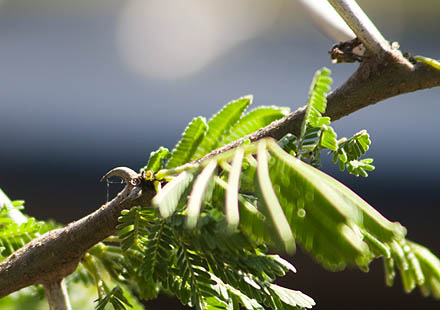
I can't imagine how giraffes work around this stuff with their lips and tongues, but they do.
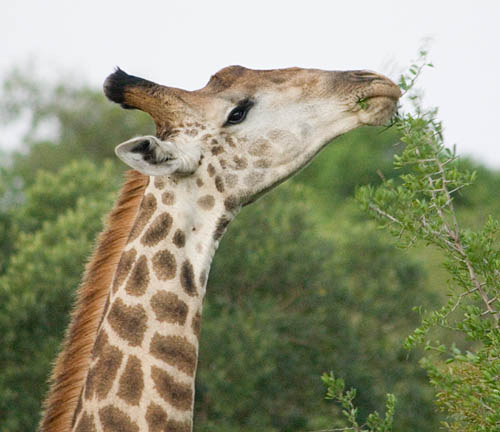
Here's a rhino with scratching post marks on his side, and a passenger perched on the middle of his back.
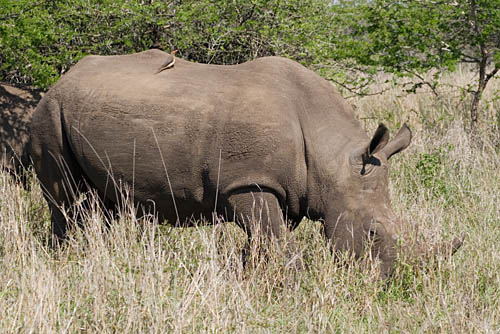
The birds like hanging out and eating the bugs the rhinos attract or flush out from the grass.
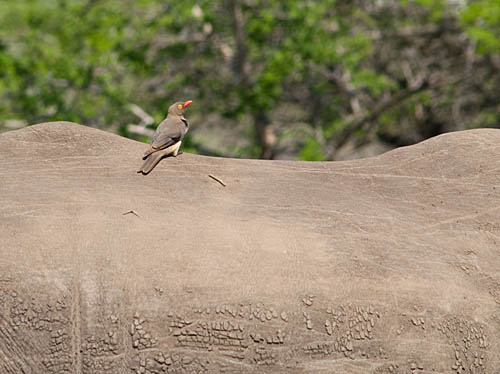
Rhinos have terrible eyesight, so they focus on sound and smell. Hearing is so important, they have developed directional hearing and can swivel their ears to track sounds. In this photo, you can see the rhino with one ear aimed at our truck and one at another truck.
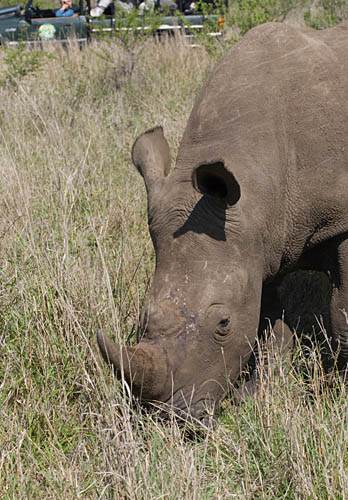
Later in the ride, we chanced upon another group of giraffes. This giraffe is just walking along in our direction, not bothered, but giving us his full attention eyes and ears.
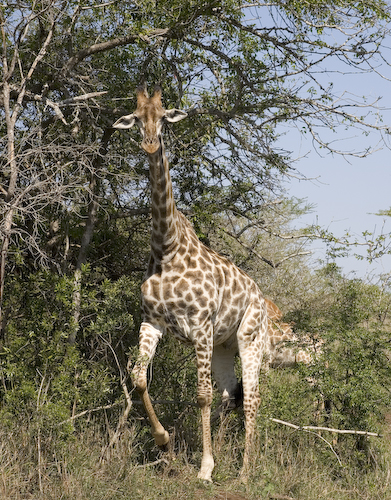
Here's another nasty plant "Buffalo Thorns" that has developed an intimidating defense system that is largely ignored by the big herbivores that munch on it anyway.
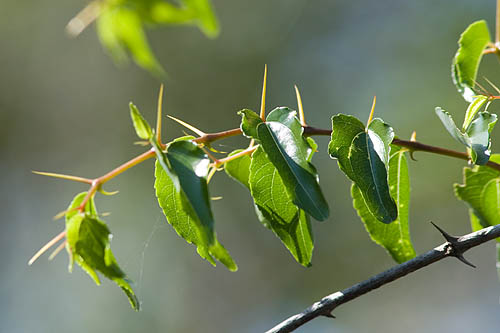
These two giraffes were getting a drink at the watering hole and playing host to birds that feed on insects from their coats. The adult male has two bird attendants, one on his shoulder and one on his "hump."
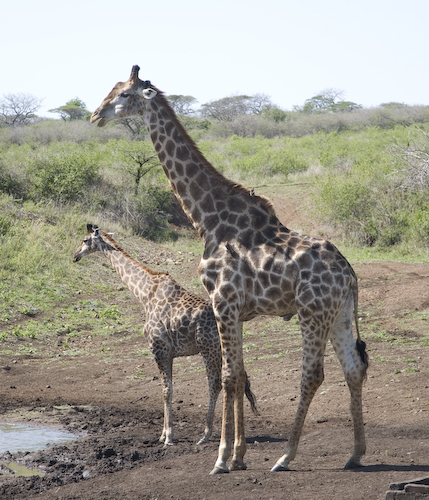
Here's the same adult male with a bird sitting on his head, just above the eye.
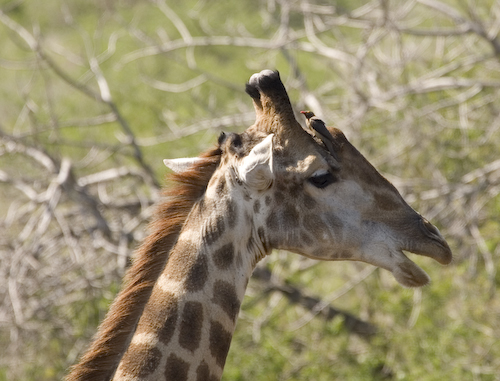
You see these iconic flat-topped trees in every movie about Africa, and in pretty much everywhere we looked while out on safari. Just so you know we really were in Africa, here's a photo of one.
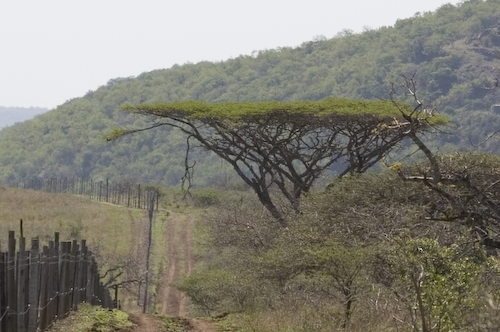
We got another look at the elephants, in the rough terrain near where we saw them with Lucky. This elephant tossed some dirt and grass up on her back to help stay cool in the sun. I guess elephants aren't so good at making hats.
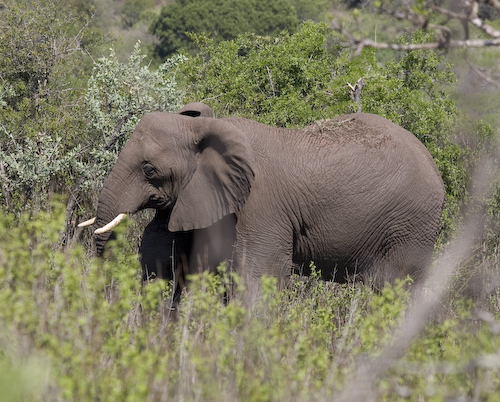
The elephants were far enough away and downhill from us that we weren't in any danger of them charging us. Marius let us get out of our seats to try to get a better look. Cathy stepped away from the group to document the moment, something that's hard to remember to do when you're seeing so many new and exciting things.
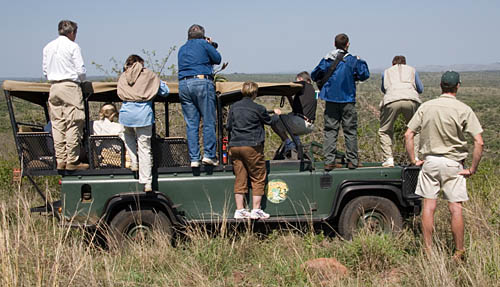
On the way out, Marius had to get out of the truck to move a couple of rocks out of the path. As he rolled one rock over he exclaimed, "Ah! Scorpions! That's what I'm talking about."
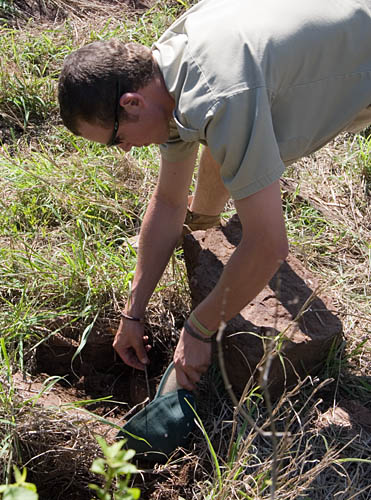
He carefully herded a huge scorpion into his hat so he could show it to us. We were all appalled at how nasty it looked, especially after he explained what it's like to get stung: every time your heart beats and sends blood through the sting, it feels like someone hits you with a hammer as hot as a lit cigarette. Although the scorpion venom is not generally life-threatening, this pain lasts for a couple of hours. He was, or course, speaking from experience.
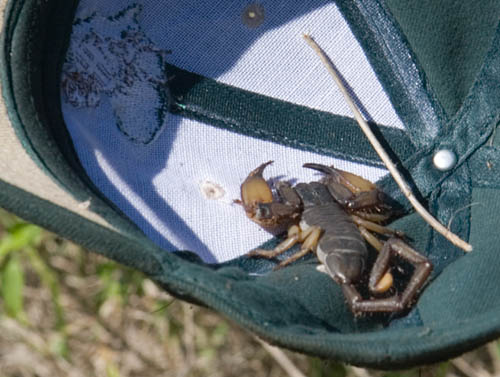
After we all had a look, Marius placed the hat and scorpion off to the side of the truck, drove past, then carefully returned the scorpion and rock to their original locations. I understand being nice to deer and bunnies, but it takes a true conservationist to be kind to a species after having been subjected to the burning-hammer-pounding experience.
Sunday Afternoon, September 10
On the way to Phinda, we saw a baboon run across the road, too quick to take a photo. They are unusual at Zulu Nyala since it lacks the sort of fruit trees the baboons like to feed on.
Around the lodge at Phinda, we saw several red duikers, miniature antelope with a a cute little tail that wags dog-like. This little guy was wandering through the tangle of trees near the lodge and wouldn't hold still long enough to compose a good photo, so we're stuck with this one.
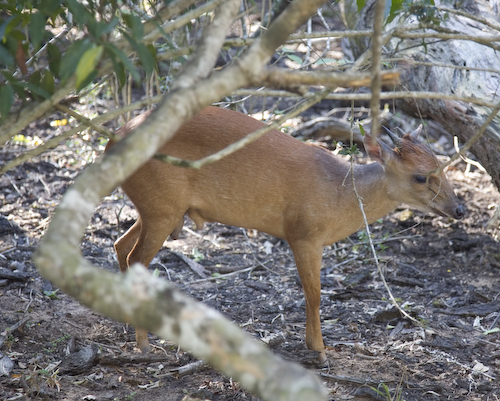
The touring vehicles are similar to Zulu Nyala in that they have four rows of seats on a long all-terrain vehicle, but the seats rise up front-to-back, there are no enclosing bars or roof, and there's a scout seat mounted at hood level hanging over the front bumper on the passenger side. Kai was our driver and Sibusiso was our scout. Kai explained that if we found elephants or lions, we would need to make space for Sibusiso to join us in the passenger seating before he got eaten.
The Phinda park is 24,000 hectares compared to Zulu Nyala's 2,000 (with a hectare being about 2.5 acres), so Phinda has enough ground to support two lion prides. Our evening's plan was to traverse the perimeter of a marsh area where we were hoping to see a cheetah and perhaps elephants and lions.
As we drove through the sandy forest (a very rare terrain type), we saw a pair of dung beetles wrestling a baseball-sized dung ball along the road. The typical behavior is for the female to sit on top of the ball and direct the male rolling it along, which they were kindly demonstrating for us. At one point the female was clearly not satisfied with the progress they were making, so she hopped down and showed the male how to do it. You can imagine the sort of obvious comparison to human behavior that whole process inspired.
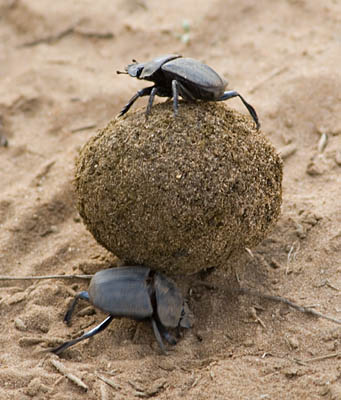
As we reached the perimeter fence, we saw another baboon apparently contemplating hopping over. It was good to have a massive zoom lens.
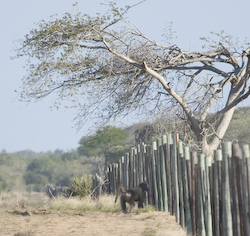
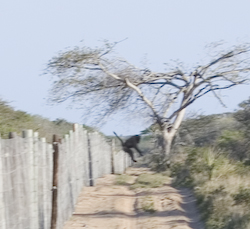
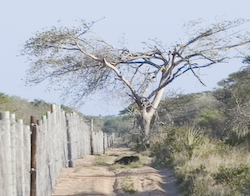
The animals we saw all the time at Zulu Nyala include the impala, nyala, wart hogs, and zebra. Phinda was no different. Another similarity is the ranger/guide humor which requires every guide to tell the same joke upon the first zebra citing with new passengers. "Does anyone one know how to tell the difference between male and female zebra?" After whatever blank stares or wild guesses this precipitates, the answer is revealed, "Female zebras have black stripes on white, while male zebras have white stripes on black." We heard that joke from Marius (twice), Lucky, and then Kai.
Here's a young zebra leaning against Mom's rump.
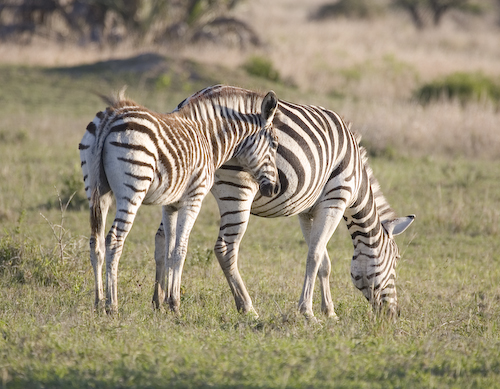
This warthog seems to think he's a zebra. Or maybe it's just that herbivores like to hang out together; there is safety in numbers. The more friends you have, the less likely it is that you'll get eaten.
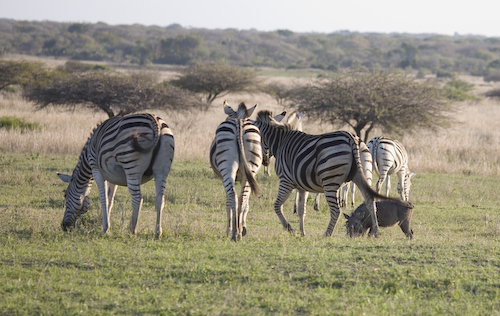
We had no joy finding the cheetah, but we did see some rhino and a huge bull elephant. Yikes! I'm glad we didn't have a truck pushing contest with him!
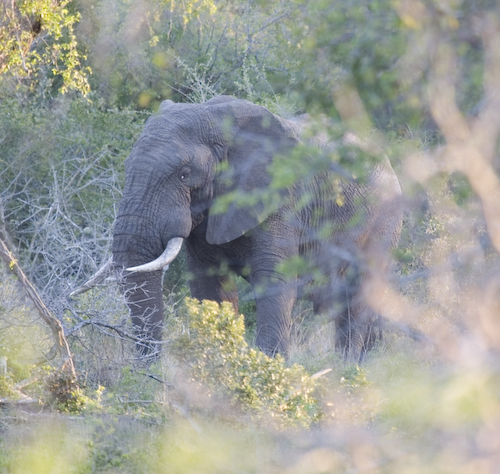
Finally, Kai got a call on the radio that the lion pride was found and we could move in as soon as one of the other three trucks was done. His instructions were to slowly make his way over to the lion location. He of course immediately turned around and made a beeline in that direction. By the time we were close, we were granted a spot and Sibusiso got out of the lion bait chair and we all went into quiet mode: no loud noises, no quick movements. Something as stupid as the loud noise of dropping a camera could excite a lion and cause a real problem.
As we pulled into a clearing, we saw the other trucks. Although somewhat obscured by knee-high grass, we could make out a clump of sleeping lions! As the lions slept, one was clearly having some lion dream, stretching and kicking a leg in the air. It was close to sundown and the light was draining away, making photographs difficult. Still, the spectacle of being within 10 or 20 yards of seven full-grown 100% wild lions was riveting.
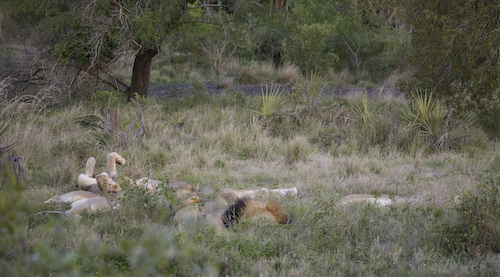
This female was sleeping a few feet from the others and was the closest of the pride to our truck. Maybe she was the sentry.
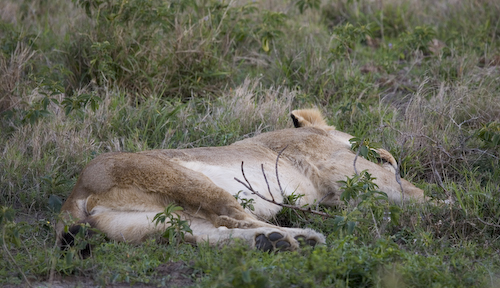
A different female raised her head to have a sleepy look around.
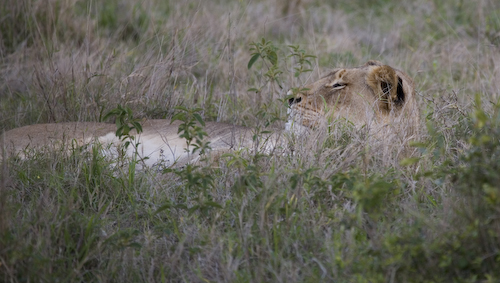
Here's the dominant male doing his part: stretching.
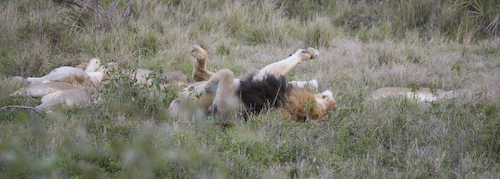
... show us your belly ...
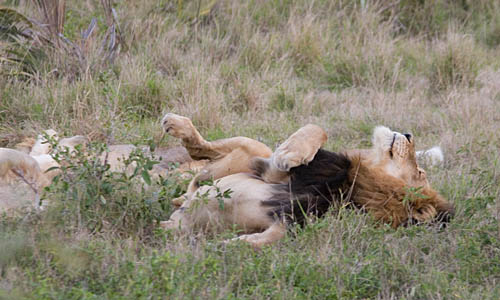
... roll and scratch ...
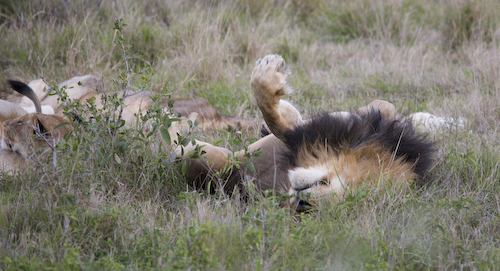
As the light was dropping below practical photography levels, the lions started to wake up. The close female was the first to stir, starting with a stretch...
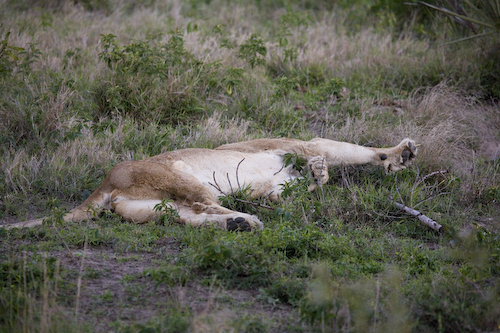
peek with one eye
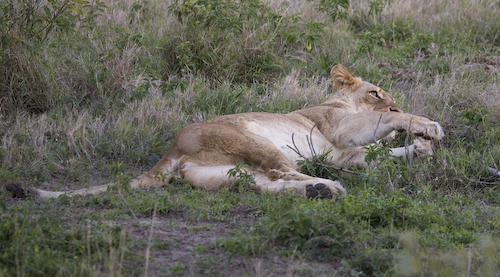
squint
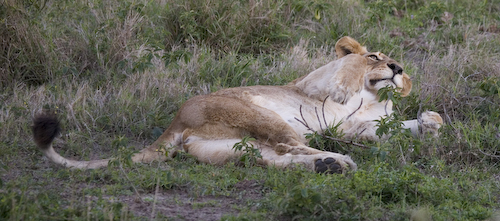
ah, forget it
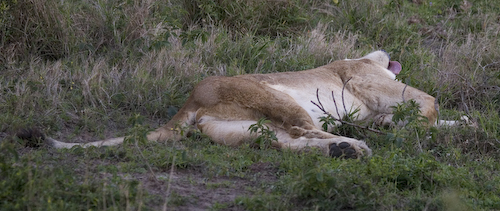
stretch again
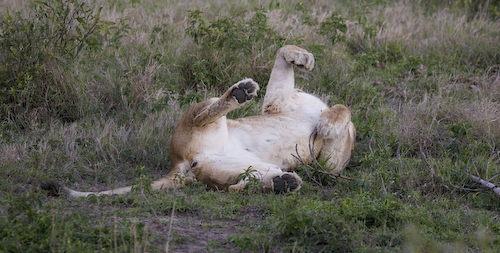
and roll over
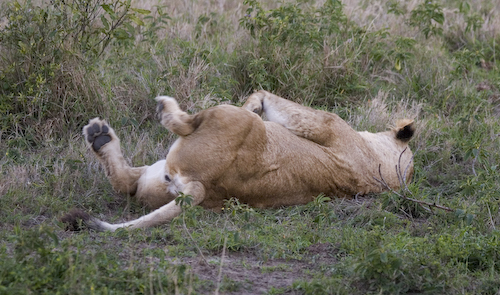
Soon others were perking up while the close lioness was doing a bit of "morning" grooming.
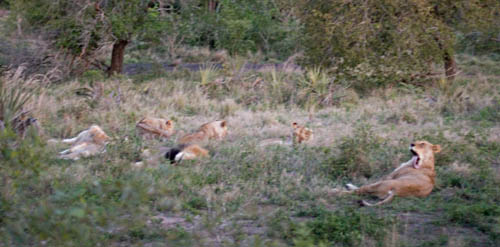
As it got really too dark to take photos, she got up on her feet and slowly walked toward us to take a leak a few yards in front our our truck. She didn't seem to notice us at all, but we all knew she was aware of us. As the other females woke up, they followed suit, all parading right in front of the truck to relieve themselves and stretch their legs. The guide assured us that flashes were OK, they wouldn't excite the lions. Cathy was brave enough to snap this one, and sure enough, no one got eaten.
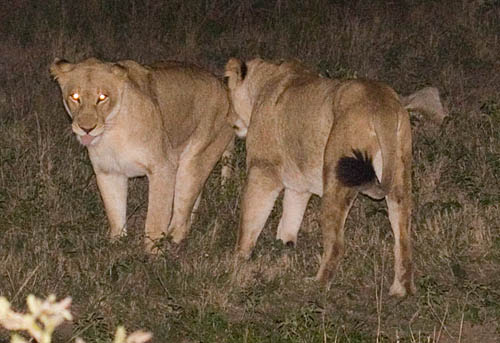
The huge dominant male and his two lieutenants were the last ones to wake up. The black-maned beast and one of the boys wandered over in front of the truck just like everyone else and stopped to sample the scent from where the first female had let loose. Shoulder-to-shoulder, they faced us and simultaneously opened wide their massive jaws exposing their unbelievably large teeth. The big male would not even have to stretch to put his jaws around any of our heads. Forget about photos, or even zoos, you haven't seen a lion until you've looked down the throat of a lion standing less than a second away with nothing keeping him from making you his next snack other than his whim and you not doing anything to startle him.
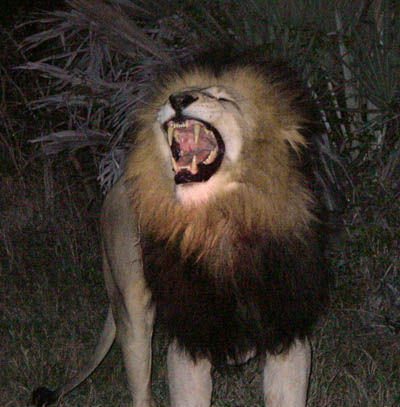
Above photo © 2006 Robert Jenkins, all rights reserved. Used here by permission.
We tourists were all sure the lions were showing their choppers just to remind the spectators who is king of the jungle. The guides set us straight: it wasn't about us. They were just getting the female scent up into their best smell hardware through the roofs of their mouths. The guides explained the physiology, but all I could think of were those cavernous jaws.
After completing their wake-up routine, the lions headed out in search of dinner. We'd had a good look, so we took off to let another group come in and try to track the lions as they set about their evening hunt.
After the lions were gone, it was time for the Phinda signature safari picnic. Kai and Sibusiso hauled out coolers with snacks and drinks. They used the scouting spotlight to illuminate the portable bar as the last of the light left the sky. It was a little unnerving getting out of the truck, in the dark, knowing there were lions hunting in the vicinity. We were on the edge of a pond that looked a lot like the pond at Zulu Nyala where the crocodile lives. Do crocodiles hunt at night? After seeing that no one was getting eaten, almost everyone eventually got out of the truck to stretch their legs and enjoy the drinks and snacks.
After we'd all had enough of pretending to be relaxed standing around in the dark at the lion meat market, the guides packed up the picnic and turned off the lights. The dark skies gave us a good opportunity to see the stars and constellations of the southern hemisphere. We saw the Southern Cross and learned how to find the south pole (the southern equivalent of the spot conveniently marked by the North Star). The Milky Way was bright and vivid directly overhead. The large Magellan Cloud (a satellite galaxy of our Milky Way galaxy) was faintly visible lower in the sky. As we were doing our tour of the sky, Cathy said she could imagine coming back to Africa and doing this some more. That may have just been the hot cocoa talking.
On the way back, Sibusiso was using a spotlight to try to find a leopard. We didn't get that, they are hard to find, the trickiest of the "big five" to see. (The so-called "big five" is the safari check list: lion, elephant, rhino, water/cape buffalo and leopard. We saw four of the five that outing.) Sibusiso did find a barn owl, wide (white?) tail mongoose, and a black neck chameleon. Sibusiso was amazing. I don't know how he found that chameleon, it was a tiny green bump on a plant that was hard to see even when Kai walked up to the bush and pointed it out. Wow.
As an added bonus, Marius found a porcupine during the drive back to Zulu Nyala.
Sunday Night, September 10
Marius joined us for dinner and told us some wild tales. His mom does not approve of his adventurous vocation, and it doesn't help when he calls her from the hospital to update her on the latest. He's had tick fever four times, been bitten by poisonous snakes several times, stung by a scorpion, plus who knows how many lesser bites and wounds.
At the Zulu Nyala lodge, the diners are frequently treated to a Zulu dance by some of the locals in traditional native garb. Marius grew up on a farm with Zulu kids and speaks fluent Afrikaans, Zulu, and English. He told us about one night when, during the dance show, all of the Zulus suddenly stopped their dance and ran up to high ground shouting (in Zulu) "Snake! Snake! Snake!" Marius was only one to understand what they were shouting about and told the staff what was going on. He found the snake: a freaked out spitting cobra. Using a large clear glass bowl from the kitchen as a shield, he was able to approach and subdue the snake without getting sprayed with venom that can blind you.
He of course had previous experience where he got sprayed above the eyes with venom and didn't know it (he was watching through a camera) until sweat carried some of the venom into his eyes. In case you ever find yourself with spitting cobra venom in your eyes, the best first aid is contact lens saline solution. Second best is urine. When you have cobra venom burning in your eyes, you're not too fussy about which of the two is available.
Marius also told us some interesting facts about lions. If you're guiding a walking tour and come across lions, you're allowed to shoot any lion within 20 yards because if a lion is that close, you're one leap and a fraction of a second from being food. We all found it interesting he didn't share that tidbit with us before we camped out 20 yards from seven lions. The good news is that lions don't generally think of people as prey, unless we do something threatening or antelope-like (such as try to run away). We were safer in the truck than on foot, but, unlike elephants, lions are smart enough to recognize us as individuals even in the truck.
All photos ©2006 Tom and Cathy Saxton. All rights reserved.
|
©1996-2025 Tom and Cathy Saxton. You may not copy or reproduce any content from this site without our consent.